THE ORANGE NYMPH
This is a very good-looking attractor nymph pattern originated by Joe Cornwall. The first time I saw this fly, I thought it was a beautiful pattern! I really like the black tips on the Golden Pheasant Tippet fibers. They look like the hairy footpads some swimming insects use for propulsion. They can also resemble the black edges found on certain small fish.
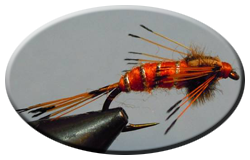
Materials:
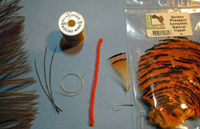
- Hook: Size 8, 10 or 12; 3xl streamer hook
- Weight (optional): 8 turns of .020 lead (or lead-free) wire under the thorax. This pattern also lends itself to using a beadhead for weight if desired.
- Thread: Black 6/0
- Tail: Golden Pheasant Tippet fibers
- Ribbing: Oval gold tinsel
- Abdomen: Orange yarn, (Joe uses "I Love This Yarn" brand (sport weight) in color #200, orange.)
- Thorax: Black ostrich herl
- Wing Case: Golden Pheasant Tippet Fibers
- Legs: Golden Pheasant Tippet Fibers
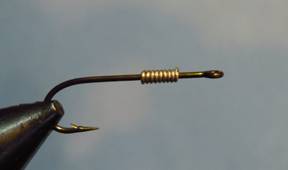 Mount the hook in the vise. If you choose to use wire for weight, add this to the hook now.
Mount the hook in the vise. If you choose to use wire for weight, add this to the hook now.
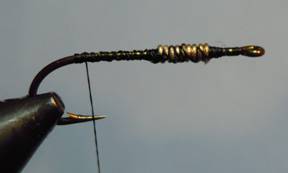 Start the thread near the hook eye, make some wraps ahead of, over, and behind the wire (if used) to secure it in place. Advance the thread to the rear of the hook shank.
Start the thread near the hook eye, make some wraps ahead of, over, and behind the wire (if used) to secure it in place. Advance the thread to the rear of the hook shank.
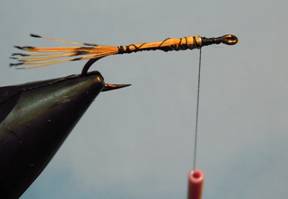 Clip @ 8-12 barbs from the Golden Pheasant neck feather. Use barbs that have the nice black middle and tip sections. Tie these in near the end of the hook shank.
Clip @ 8-12 barbs from the Golden Pheasant neck feather. Use barbs that have the nice black middle and tip sections. Tie these in near the end of the hook shank.
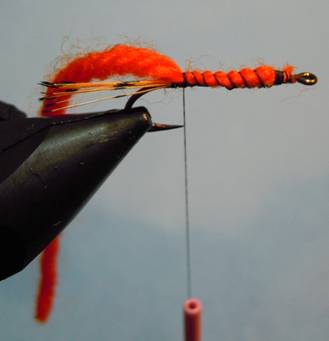 Attach a length of yarn to be used for the body. For a more uniform body, tie the tip of the yarn near the front end of the thorax (wire, if used) area, and then wind your thread over the yarn and towards the hook bend while lifting the yarn straight up or slightly up and towards you.
Attach a length of yarn to be used for the body. For a more uniform body, tie the tip of the yarn near the front end of the thorax (wire, if used) area, and then wind your thread over the yarn and towards the hook bend while lifting the yarn straight up or slightly up and towards you.
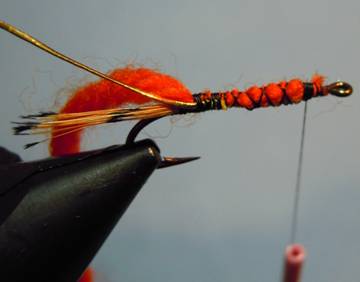 Tie in the gold oval tinsel near the end of the hook shank, with the loose end trailing back towards the vice. Advance the thread to the front of the thorax area.
Tie in the gold oval tinsel near the end of the hook shank, with the loose end trailing back towards the vice. Advance the thread to the front of the thorax area.
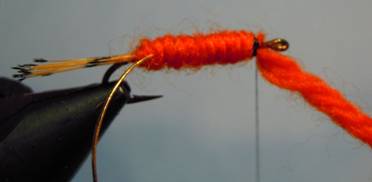 Wrap the chenille around the hook shank towards front of the thorax area, putting one wrap to the rear of the tinsel. Tied off the chenille and cut off the excess.
Wrap the chenille around the hook shank towards front of the thorax area, putting one wrap to the rear of the tinsel. Tied off the chenille and cut off the excess.
 Make about 4-6 wraps with the tinsel, and tie it off in the thorax area.
Make about 4-6 wraps with the tinsel, and tie it off in the thorax area.
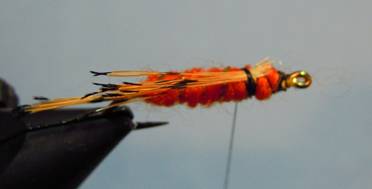 Clip about 20 barbs from the Golden Pheasant neck feather. Tie the base of the barbs into the top of the thorax area, so the black tips extend back towards the tail of the fly.
Clip about 20 barbs from the Golden Pheasant neck feather. Tie the base of the barbs into the top of the thorax area, so the black tips extend back towards the tail of the fly.
 Tie 3 black ostrich herls onto the top of the thorax area so the loose ends extend back towards the tail of the fly.
Tie 3 black ostrich herls onto the top of the thorax area so the loose ends extend back towards the tail of the fly.
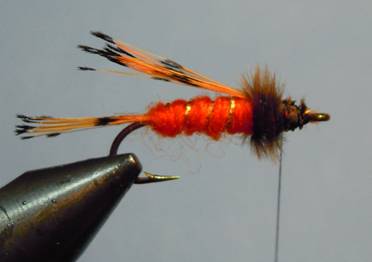 Twist the ostrich hurls into a rope, and wrap them around the hook shank to the front of the thorax area. Tie off and clip off the excess. (Leave about one-and-a-half hook-eye lengths clear in front of the thorax.)
Twist the ostrich hurls into a rope, and wrap them around the hook shank to the front of the thorax area. Tie off and clip off the excess. (Leave about one-and-a-half hook-eye lengths clear in front of the thorax.)
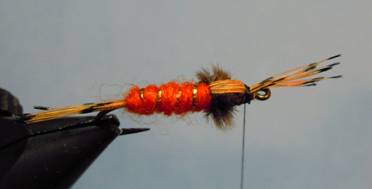 Pull the tips of the golden pheasant barbs forward, and tie to the hook shank in front of the thorax.
Pull the tips of the golden pheasant barbs forward, and tie to the hook shank in front of the thorax.
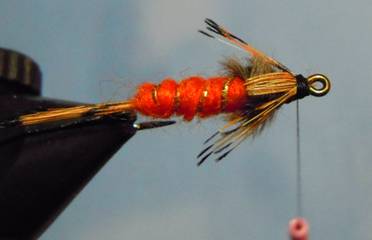 Split the barb tips in approximately 2 equal bunches, and pull them back to opposite sides of the thorax. Wrap thread in front of and then onto the bends of these barbs to hold them in place. You want the legs to be angled towards the rear of the hook, but also flare out from the body of the fly somewhat. (This step is much like finishing off the legs on a Pheasant Tail Nymph.)
Split the barb tips in approximately 2 equal bunches, and pull them back to opposite sides of the thorax. Wrap thread in front of and then onto the bends of these barbs to hold them in place. You want the legs to be angled towards the rear of the hook, but also flare out from the body of the fly somewhat. (This step is much like finishing off the legs on a Pheasant Tail Nymph.)
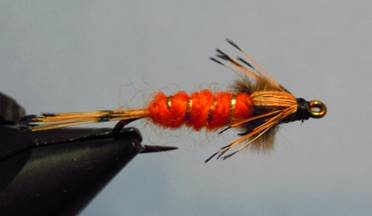 Make a nice thread head and finish tying off in your preferred method. Clip the excess thread and the fly is complete.
Make a nice thread head and finish tying off in your preferred method. Clip the excess thread and the fly is complete.
Fish this as you would your other nymph patterns.
It may take a few tries (it did me, anyway) to get the legs to look about right. Experiment to see if the fish in your area prefer longer or shorter legs.
You can always trim off some of the legs if it looks like there are too many, or if some are sticking out at unsightly angles.
For smaller sizes or for a narrower body profile, you can separate strands of the yarn and use whatever suits you.
Joe’s original pattern calls for an orange body (hence the name), but I believe other body colors could be substituted to match local nymphs or color patterns that work for you, yet retain the overall concept of this pattern. I’ve tied them with an olive body. I’ve also tied them with white bodies and chartreuse bodies, and substituted white Lady Amherst Tippet fibers in place of the Golden Pheasant Tippet fibers.

For more great info, check out:
Beginning Fly Tying | Intermediate Fly Tying | Advanced Fly Tying.
